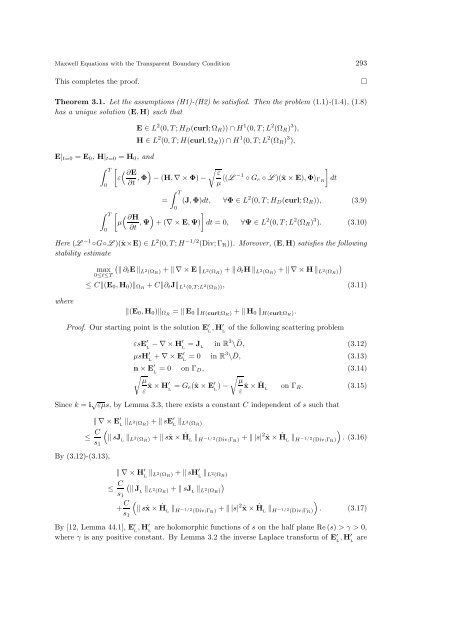ON MAXWELL EQUATIONS WITH THE TRANSPARENT ...
ON MAXWELL EQUATIONS WITH THE TRANSPARENT ...
ON MAXWELL EQUATIONS WITH THE TRANSPARENT ...
You also want an ePaper? Increase the reach of your titles
YUMPU automatically turns print PDFs into web optimized ePapers that Google loves.
Maxwell Equations with the Transparent Boundary Condition 293<br />
This completes the proof.<br />
□<br />
Theorem 3.1. Let the assumptions (H1)-(H2) be satisfied. Then the problem (1.1)-(1.4), (1.8)<br />
has a unique solution (E,H) such that<br />
E ∈ L 2 (0, T; H D (curl; Ω R )) ∩ H 1 (0, T; L 2 (Ω R ) 3 ),<br />
H ∈ L 2 (0, T; H(curl, Ω R )) ∩ H 1 (0, T; L 2 (Ω R ) 3 ),<br />
E| t=0 = E 0 , H| t=0 = H 0 , and<br />
∫ T<br />
[ ( ∂E<br />
)<br />
√ ]<br />
ε<br />
ε<br />
∂t ,Φ − (H, ∇ × Φ) −<br />
µ 〈(L −1 ◦ G e ◦ L )(ˆx × E),Φ〉 ΓR dt<br />
0<br />
∫ T<br />
0<br />
=<br />
∫ T<br />
0<br />
(J,Φ)dt, ∀Φ ∈ L 2 (0, T; H D (curl; Ω R )), (3.9)<br />
[ ( ∂H<br />
) ]<br />
µ<br />
∂t ,Ψ + (∇ × E,Ψ) dt = 0, ∀Ψ ∈ L 2 (0, T; L 2 (Ω R ) 3 ). (3.10)<br />
Here (L −1 ◦G◦L )(ˆx×E) ∈ L 2 (0, T; H −1/2 (Div; Γ R )). Moreover, (E,H) satisfies the following<br />
stability estimate<br />
(<br />
‖ ∂t E ‖ L2 (Ω R) + ‖ ∇ × E ‖ L2 (Ω R) + ‖ ∂ t H ‖ L2 (Ω R) + ‖ ∇ × H ‖ L2 (Ω R))<br />
max<br />
0≤t≤T<br />
≤ C‖(E 0 ,H 0 )‖ ΩR + C‖∂ t J‖ L 1 (0,T;L 2 (Ω R)), (3.11)<br />
where<br />
‖(E 0 ,H 0 )‖ ΩR = ‖E 0 ‖ H(curl;ΩR) + ‖H 0 ‖ H(curl;ΩR).<br />
Proof. Our starting point is the solution E ′ L ,H′ L<br />
of the following scattering problem<br />
εsE ′ L − ∇ × H′ L = J L<br />
in R 3 \ ¯D, (3.12)<br />
µsH ′ L + ∇ × E′ L = 0 in R3 \ ¯D, (3.13)<br />
n × E ′ L = 0 on Γ D, (3.14)<br />
√ µ<br />
ε ˆx × H′ L = G e(ˆx × E ′ L ) − √ µ<br />
ε ˆx × ĤL on Γ R . (3.15)<br />
Since k = i √ εµs, by Lemma 3.3, there exists a constant C independent of s such that<br />
‖ ∇ × E ′ ‖ L L 2 (Ω R) + ‖ sE ′ ‖ L L 2 (Ω R)<br />
≤ C (‖ sJ<br />
s<br />
L<br />
‖ L 2 (Ω R) + ‖ sˆx × ĤL ‖ H −1/2 (Div;Γ R) + ‖ |s| 2ˆx )<br />
× ĤL ‖ H −1/2 (Div;Γ R) . (3.16)<br />
1<br />
By (3.12)-(3.13),<br />
‖ ∇ × H ′ ‖ L L 2 (Ω R) + ‖ sH ′ ‖ L L 2 (Ω R)<br />
≤ C ( )<br />
‖JL ‖ L<br />
s 2 (Ω R) + ‖ sJ L<br />
‖ L 2 (Ω R)<br />
1<br />
+ C (‖ sˆx ×<br />
s ĤL ‖ H −1/2 (Div;Γ R) + ‖ |s| 2ˆx )<br />
× ĤL ‖ H −1/2 (Div;Γ R) . (3.17)<br />
1<br />
By [12, Lemma 44.1], E ′ ,H′ are holomorphic functions of s on the half plane Re (s) > γ > 0,<br />
L L<br />
where γ is any positive constant. By Lemma 3.2 the inverse Laplace transform of E ′ ,H′ are L L
















